In mid-March 2020, in light of the Covid-19 pandemic, the almost complete government paralysis of economic activities put most of the economy of Bosnia and Herzegovina (B&H) into hibernation. Like in other countries, this decision had a devastating impact on the economy of B&H, with quickly and sharply rising unemployment, falling consumption and public revenues, closure of businesses, and the like.
In following April, different levels of government in the country begun to formulate and partially implement economic measures in response to the crisis. This paper analyzes economic implications of the Covid-19 pandemic in B&H, with particular consideration of governmental “corona” measures.
In addition to the macroeconomic analysis, the paper also explores the perceptions of the business community regarding the impact of the pandemic on their business, government measures and their effectiveness, and their anticipation of the future – present optimism.
Measures taken by various levels of government in B&H to address the economic and other consequences of the Covid-19 pandemic are viewed as insufficient and belated. Most respondents believe that the pandemic will change people’s consumption and lifestyle, but also that it represents a chance to modernize businesses and business models.
Introduction
The outbreak of the new coronavirus disease 2019 (COVID-19) has infected millions of people worldwide, with hundreds of thousands of dead (European Centre for Disease Prevention and Control 2020). Countries are battling the spread of the virus to protect their citizens by closing international borders and imposing restrictions on movement, gatherings, and working hours (CMS 2020).
According to ILO (2020a), full or partial lockdown measures were in March alone affecting almost 2.7 billion workers – four in five of the world’s workforce. As of 1 April 2020, the ILO’s (2020b) new global estimates indicate that working hours will decline by 6.7 per cent in the second quarter of 2020, which is equivalent to 195 million full-time workers.
Also, 1.6 billion workers in the informal economy stand in immediate danger of having their livelihoods destroyed.
However, the shock to the labour market is far from uniform, with specific sectors bearing the brunt of the collapse in economic activity. The current estimated impact on global GDP growth for 2020 is from -3% (IMF 2020a) to -4.6% (Fitch Ratings 2020).
In a baseline scenario that assumes that the pandemic fades in the second half of 2020 and containment efforts can be gradually unwound, the global economy is projected to grow by 5.8% in 2021 as economic activity normalizes (IMF 2020a).
By June 2020, B&H recorded 2,493 coronavirus cases since the epidemic began in March (Worldometers 2020). In the meantime, the country reported 152 coronavirus deaths (Trading Economics 2020).
According to healthcare experts, B&H health sector managed to respond well to the pandemic, primarily in organizational and professional terms, because it did not have a significant number of cases, as well as deaths (Privredna komora FBiH 2020).
Before Covid-19, the economy showed its first signs of a slowdown already in 2019. The causes are mainly external factors. B&H has a high share of goods in total exports and thus is tightly connected to global value chains (World Bank 2020b). The main trading partners are Germany, Italy, Croatia, and Austria, with a strong focus on textiles and basic metals and close links with the car industry.
Indeed, foreign trade has deteriorated significantly due to negative economic trends in trading partners, as well unexpected developments in relations with them (i.e., economic recession in Italy, the slowdown in the German economy, the introduction of a 100% import tax on products from B&H by Kosovo, and the decline in the value of the Turkish lira in the second half of 2018).
Further, due to the closure of Mostar’s industrial giant “Aluminij” in mid-2019, problems in the operations of chemical company GIKIL Lukavac, as well as the oil refinery in Bosanski Brod, the rest of 2019 was marked by a decrease in exports compared to the same period in 2018.
These individual events, combined with the overall slowdown in the economy, created the preconditions for a strong negative impact of the global crisis caused by the outbreak of the Covid-19 pandemic.
The economic effects of the crisis in B&H began in January 2020, when the closure of the Chinese economy threatened global supply chains. In mid-March 2020, B&H declared a state of emergency, hindering or preventing companies from operating, resulting in many of them to close.
The impact on revenues of all big companies was extreme (Deloitte 2020). Various restrictions, implemented by the state, entities (The Federation of Bosnia and Herzegovina and the Republika Srpska) and local governments in B&H, drastically slowed the economy down, forcing many of the small and mid-size businesses to close permanently.
A noticeable rise in unemployment and slowdown of production in almost all sectors, as well as a sharp decline in the exports (EBRD 2020) estimates that exports will decline more than 40% of GDP) due to the drop in foreign market demand throughout the April 2020 were the top concerns for the domestic leaders and experts (Stopić 2020). In April and May 2020, the so-called “Corona laws” were passed to support the economy. These measures differ according to the complex federal structure of the state (Hogić 2020).
By violating freedom of movement, as well as freedom of assembly, the executive power in B&H, left citizens in a state of legal uncertainty (Muratagić 2020), which also affected economic uncertainty. To address the additional financing needs, the authorities have requested emergency financial assistance from the IMF, the World Bank, and the European Union. On April 21, 2020, the IMF Board approved a EUR 330 million loan under the Rapid Financing Instrument (RFI) to help the country meet its financing needs (Stopić 2020).
From the middle to the end of May, as the state of emergency was lifted, the economy was becoming more and more open.
Strict lockdown in B&H has caused a sharp halt to economic growth, with supply chains being disrupted and service sector being hit hard. Researching the impact of Covid-19 on tourism in B&H, Peštek (2020) finds that, based on information on March 2020, 79.4% of respondents expect a reduction in business volume between 61% and 100%.
The Foreign Trade Chamber of B&H (2020) finds that on a sample of 410 companies, mostly from the manufacturing industry, 92% felt the consequences of the pandemic, while 71% felt the implications for both exports and imports.
Crucially, UNDP (2020) analysis shows that smaller firms in key sectors have already been more exposed to the negative effects of the Covid-19 pandemic, and are less prepared to deal with the forthcoming indirect impacts.
However, larger firms tend to have greater, more developed supply chains and will, therefore, be subject to more significant external shocks. Low-skilled workers and young professionals are two vulnerable groups most prone to being negatively affected as a result of the pandemic-induced economic downturn.
Estimates of the economic downturn for B&H vary. IMF (2020b) predicts an economic decline of 5% in 2020 and recover to 3.5% in 2021. The EBRD (2020) predicts a decline of -4.5% in 2020 and a recovery of 6% in 2021. Earlier, the World Bank (2020a) had a pre-Covid-19 crisis projection of economic growth of 3.4%.
Čavalić, Hadžić and Bećirović (2020) estimate that the economy will fall by 3,97% to 9,53%, with a loss of 30,000 to 100,000 jobs, according to different macroeconomic scenarios. Regarding the financial markets, OECD reports that the local currency “BAM” has depreciated around 3% since the beginning of the year, signaling a potential capital outflow and rendering international trade and investment decisions more difficult.
When it comes to the stock market, the SASX-10 index lost around 11% of its value from 10 January to 20 May (OECD 2020).
The World Bank, as a key economic challenge for B&H in the light of the Covid-19 pandemic, lists long-term unemployment, as well as several financial risks originating in pensions, arrears, and SOE liabilities. The most significant external risk is related to low growth in the EU and political tensions in the region (World Bank 2020a).
As the B&H economy relies heavily on trade, manufacturing, and remittances, with the latter accounting for more than 10% of GDP, it is vulnerable to both the breakdown of EU production chains and a drop in workers’ remittances. Indeed, EBRD (2020) estimates that remittances shall drop for 11% of GDP, which will have a further negative impact on consumption.
An extensive public opinion poll conducted by Ipsos B&H shows that on a national level concern for one’s own health is at amount the same level as concern for the economic consequences of the epidemic. In contract, the Sarajevo canton citizens are particularly concerned about economic prospects (job loss, global recession, etc.) (UNICEF 2020).
Research Methodology
The analysis consists of two segments. The first part of the research is the analysis of macroeconomic indicators for B&H during the crisis caused by the Covid-19 pandemic. To estimate the decline in GDP in 2020, a linear regression model was used with a time series of 48 quarterly values. The collected data were analyzed and processed in Python.
The second part of the analysis examines the attitudes of business owners and managers towards the the aftermath of the Covid-19 pandemic and its consequences. Primary data were used, collected by a questionnaire with a four-point Likert scale in the period May 1-29, 2020 on the territory of B&H.
The obtained data were analyzed using descriptive statistical analysis, ANOVA, and t-test of independent samples.
Analysis of Macroeconomic Indicators after the Outbreak of the COVID-19 Pandemic
This part of the research analyzes data related to changes in foreign trade, industrial production, unemployment, and tax revenues. It also provides a projection of GDP for this year, based on the first, preliminary available data on consumption due to a fall in indirect tax revenues.
In March 2020, imports and exports declined significantly, as shown in Figure 1. Imports in B&H decreased by EUR 149,9 million compared to March 2019, while exports decreased by EUR 71,9 million in the same comparison. Data for April 2020 show an even more significant decline, as exports decreased by EUR 173,1 million and imports decreased by EUR 315,5 million, both in comparison to March 2019.
Figure 1: Change of Export / Import from previous period (EUR 000)
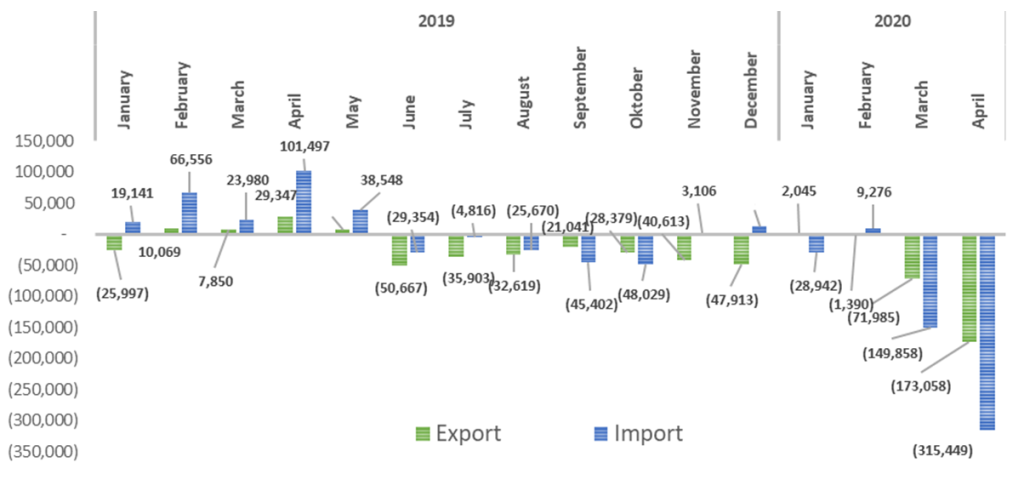 Source: Agencija za statistiku BiH (2020c and 2020d).
Source: Agencija za statistiku BiH (2020c and 2020d).
A similar trend was recorded in the segment of industrial production (see Figure 2). Industrial production was recording a constant decline from November 2018 to January 2020. A further decline at the beginning of 2020 is even more significant because it occurs on the already reduced basis from 2019. Indeed, in April 2020, this decline amounted to as much as 15.9%.
Figure 2: Industrial production in B&H (% of change previous period)
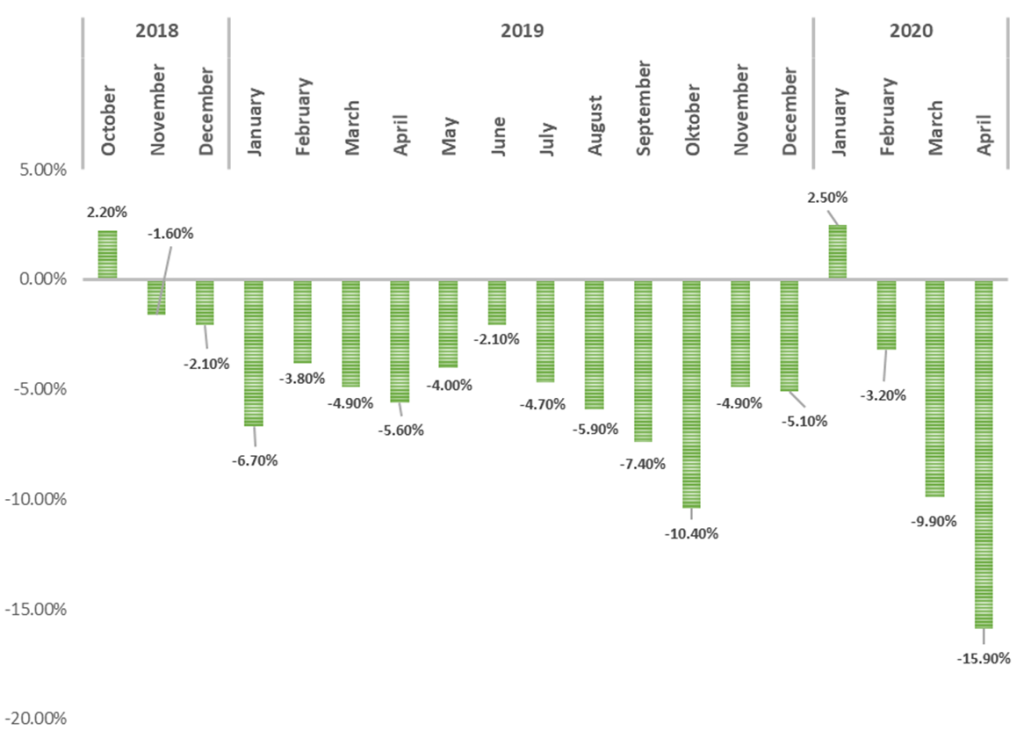 Source: Agencija za statistiku BiH (2020b).
Source: Agencija za statistiku BiH (2020b).
Unlike industrial production, which declined throughout 2019, employment in B&H grew until December 2019. The number of employees in 2019 increased by 18,000 employees. During this period, employment did grow in both the private and public sectors (Agencija za statistiku BiH 2019, 2020e).
The Covid-19 pandemic reduced employment by 31,000 in the period March-April 2020. Four main private sectors (manufacturing – C, wholesale and retail – G, accommodation and food service – I, and art and entertainment – R) accounted total of 54,14% rise in employment during the 2019, with 89,58% rise in the unemployment at the end of April 2020 (Agencija za statistiku BiH 2020).
Five main public sectors (scientific and technical activities – M, administration – N, public defense – O, education – P, healthcare – Q) increased number of employed workers by 598 at the end of the April 2020 comparing to December of 2019 (Agencija za statistiku BiH 2020). The last time, this level of employment in B&H was recorded was in April 2018 (see Figure 3).
Figure 3: Unemployment in B&H
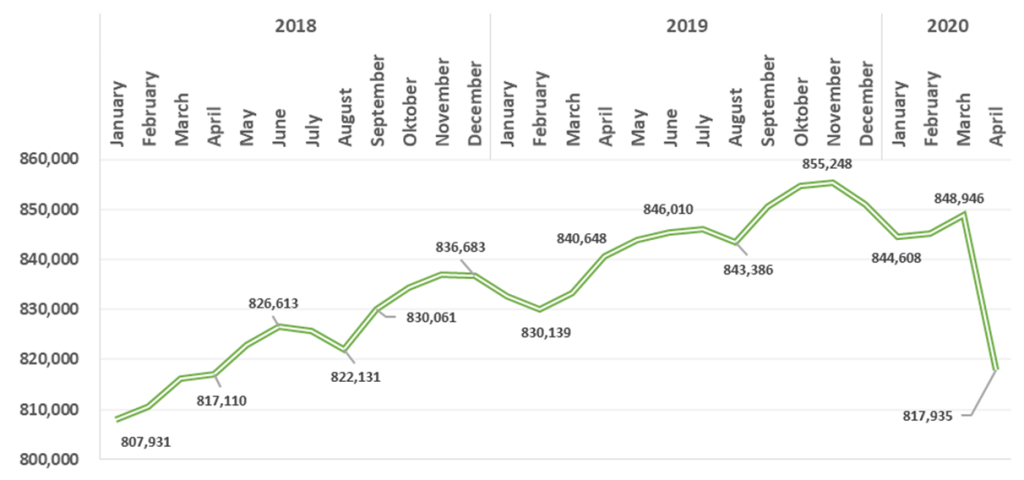 Source: Porezna uprava FBiH (2020), Agencija za statistiku BiH (2019, 2020e, 2020f) and Fond PIO Republike Srpske (2020a and 2020b).
Source: Porezna uprava FBiH (2020), Agencija za statistiku BiH (2019, 2020e, 2020f) and Fond PIO Republike Srpske (2020a and 2020b).
Figure 4 shows the comparison of tax revenues in the first quarter of 2019 and 2020. The leading components in the structure of indirect taxes are VAT and excises, while direct taxes are composed of contributions, income tax, and corporate income tax. There was a decline in all types of tax revenues and the total reduction in tax revenues for B&H amounted to EUR 134 million between the compared periods.
Figure 4: Tax revenues in B&H (in billion EUR)
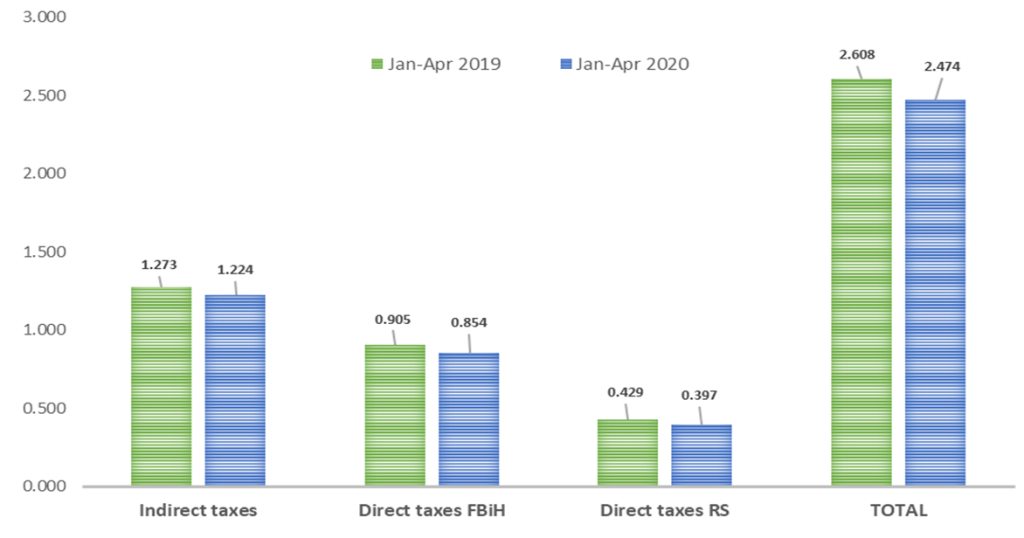 Source: UIO BiH (2020), Porezna uprava Federacije BiH (2020) and Poreska uprava RS (2020).
Source: UIO BiH (2020), Porezna uprava Federacije BiH (2020) and Poreska uprava RS (2020).
In the regression model, the household consumption of the population and GDP in B&H are linked, in constant prices, according to the expenditure principle. The linear regression model:
where Y represents estimated GDP, X represents the consumption value, -3.405.700 is a constant, and 1.8496 represents the coefficient.
The value of R-squared is 0.905, which indicates a very strong relationship between household consumption and GDP, which is to use estimating GDP trends for 2020. Due to limited and fragmented official statistics related to the decline in household consumption by quarters, we made an assessment of a decline in consumption in second quarter based on available data on the decline in collected indirect consumption taxes (VAT and excise duties).
In April 2020, the decline in collected indirect taxes was 23% compared to the same period last year. It is assumed that the fall in indirect taxes after the abolition of restrictive measures to fight coronavirus will amount to 15% in May 2020 and 5% in June 2020.
Based on the above, it is also estimated that household consumption will continue to decline in the second quarter of the year. Assuming that the total decrease in consumption in the third quarter will amount to 5% and that consumption in the fourth quarter will be at the level of 2019, we estimate GDP for B&H in 2020.
Table 1: GDP projections for Bosnia and Herzegovina
 * Agencija za statistiku BiH data.
* Agencija za statistiku BiH data.
** Own projections.
Source: Agencija za statistiku BiH (2020a) and own calculations.
Based on the GDP data for 2019 (Agencija za statistiku BiH 2020a), we estimate for B&H a decline in second quarter (2020) spending of EUR 454,6 million that leads to a second quarter (2020) decline in GDP of EUR 859,7 million.
Ultimately, the expected decline in GDP for 2020 on an annual basis is 6.34%, if the negative effects are primarily expressed in the second quarter of this year.
Analysis of the Attitudes of Business Owners and Managers Regarding the COVID-19 Pandemic
The second part of the research examines the attitudes of business owners and managers towards the aftermath of the Covid-19 pandemic and its consequences. Primary data were used, and the original survey questionnaire with a four-point Likert scale was used as an instrument for obtaining them.
The survey was conducted via the Internet (social media and e-mail) in the period May 1—29, 2020 on the territory of B&H. 1,300 accurately completed survey questionnaires were obtained, with 385 participants indicating that they belonged to a group of business owners and managers (represents a sample in this survey).
Table 2: Respondents’ views on government actions and measures to the Covid-19 pandemic
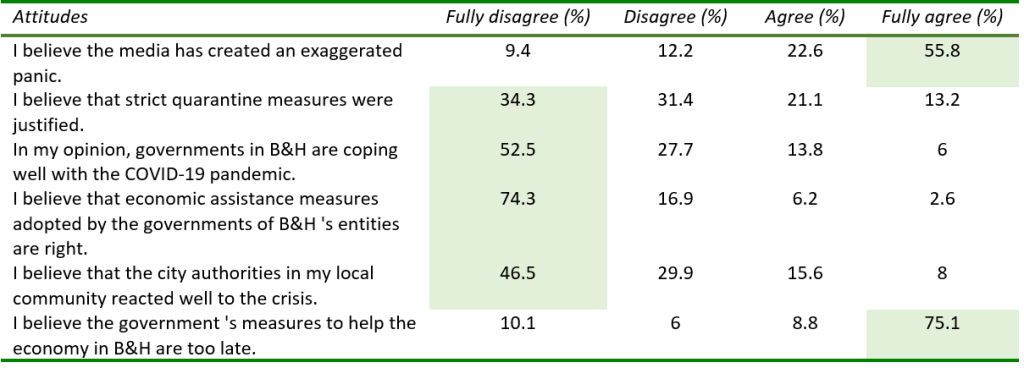
Table 2 presents the views of the respondents regarding the measures taken by the authorities in B&H, in terms of healthcare and economics in view of the Covid-19 pandemic. The highest level of the agreement (“agree” and “fully agree”) is on the view that government’s measures to assist the B&H economy came too late, as 83.9% of respondents agree with this statement.
Interestingly, 78.4% of respondents agree that the media created an unwarranted panic regarding the Covid-19 pandemic. A large percentage (91.2%) of respondents stated that they did not agree (“fully disagree” or “disagree”) that the economic assistance measures adopted by the B&H governments were right.
Also, 80.2% of respondents do not agree (“fully disagree” or “disagree”) that the B&H government is coping well with the Covid-19 pandemic.Source: Own calculations.
Respondents’ assessments of threats to business operations and personal business threats posed by the Covid-19 pandemic are given in Table 3. The largest percentage (94.2%) of respondents believe that Covid-19 pandemic crisis poses a severe threat (“large” or “very large”) to the domestic economy.
The smallest percentage of respondents (65.7%, which is still a very large number) believe that the Covid-19 pandemic poses a severe threat (“large” or “very large”) to their job loss. The majority (59.9% and 51.7%, respectively) of respondents estimate that the Covid-19 pandemic poses a “very large” threat to their company’s operations in the short and long term.
Table 3: Assessment of Covid-19 pandemic threats to business

Respondents’ views on the impact of the Covid-19 pandemic on personal and business future are shown in Table 4. It can be seen that majority (62.9%) of respondents disagree with the statement that life will normalize during the summer 2020, as well as that the economy will recover even if social distancing measures remain in force (75.6%).
While 62.9% of respondents believe that the Covid-19 pandemic is a chance to build new business models and as such modernize business, only 23.6% of respondents believe that this crisis will have a positive effect at the state level in terms of initiating the necessary structural social changes.
64.7% of respondents believe that their life after a pandemic will not be the same in terms of lifestyle and consumer habits.Source: Own calculations.
Table 4: Respondents’ attitudes about the impact of the Covid-19 Pandemic on the future
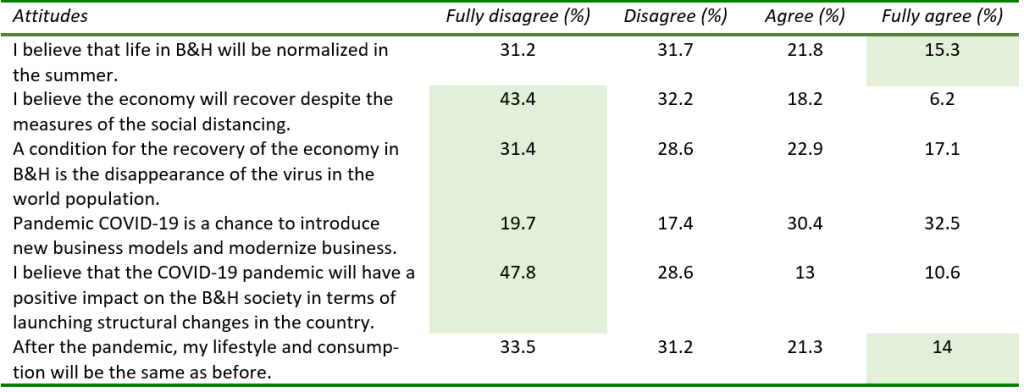
Using the t-test and ANOVA, we tested the significance of differences between respondents’ responses with respect to their socio-demographic characteristics: the position in the company, sector, type of activity and place of residence.
Table 5 shows the statistically significant results of the t-test of independent samples. Differences in attitudes between business owners and managers were tested. …Source: Own calculations.
Table 5: Independent Samples Test (position in company)
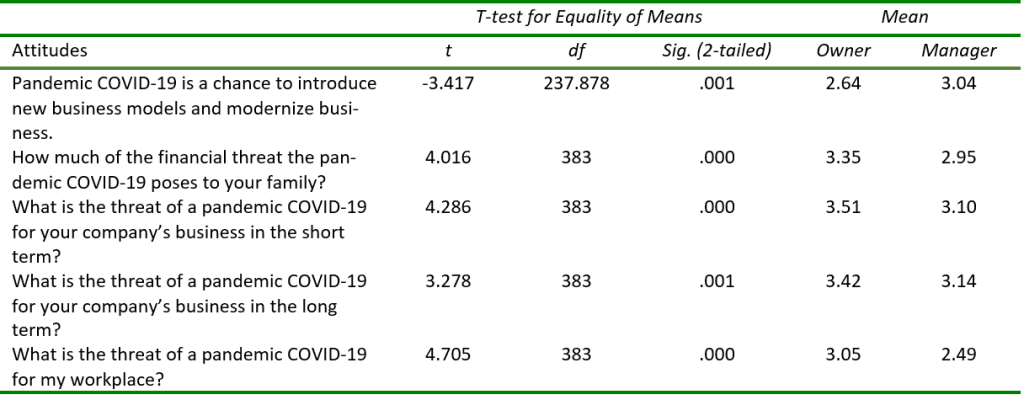
Table 6 shows the results of the t-test of independent samples where the subjects were observed from the private and public sectors. There are statistically significant differences in attitudes towards state and local government responses to the Covid-19 pandemic, where respondents from the public sector have a more positive attitude.
Respondents from the private sector assess that the pandemic is a greater danger to the economy of B&H and compared to those from the public sector.Source: Own calculations.
Table 6: Independent Samples test (sector)

When it comes to differences in respondents’ attitudes concerning whether they come from larger local communities that are also regional administrative centers or smaller local communities, a statistically significant difference was found only to the attitude of local authorities to the crisis (p = 0.001).
Although both groups have a negative attitude towards local authorities’ reactions, this attitude is somewhat milder among respondents outside administrative centers. In the ANOVA analysis, the type of activity (production, services, etc.) was observed as an independent variable, while the dependent variable was the respondents’ attitudes.
There was a statistically significant difference in attitudes between incoming respondents and production and services in relation to measures of municipal/local authorities (p = 0.0005). Although both groups have a negative attitude towards reactions to the local government pandemic, this negative attitude is more pronounced among respondents from the service industry.
When assessing to personal finances, short-term and long-term business, and job security, statistically significant differences were shown between respondents belonging to the service industry and the other two groups of respondents, with these first threats being higher (for the first three respondents’ attitudes p value is 0.0005, for the fourth p value is 0.006).
Conclusion and Discussion
Even before the economic crisis caused by the Covid-19 pandemic, B&H showed the sensitivity of the economy to negative external influences. With the closure of the economy in view of the pandemic, there has been a deterioration in most macroeconomic parameters.
In the first four months of 2020, there was a significant decline in exports and industrial production in B&H compared to the same period last year. The number of employed persons is at the level of employment as in April 2018.
Thus, in just one month the negative effects of the Covid-19 crisis managed to undo the positive effects that had been accumulating for two years.
Although in the first two months of 2020, there was an increase in tax revenues compared to the same period in 2019, the COVID-19 lockdown measures from mid-March this year, the decline in employment, exports and imports, and industrial production, harmed the growth of collected tax revenues this year.
The decline was particularly pronounced in April 2020, with both indirect taxes under the jurisdiction of the state level and direct taxes under the jurisdiction of the entities. According to the model presented in this paper, which is based on the ratio of consumption and GDP, the B&H economy will decline in 2020 for 6.34%, with ceteris paribus of other parameters.
Analysis of the original research conducted by the authors of this paper concludes that the business community in B&H is very concerned about the economic consequences of the Covid-19 pandemic crisis, both for the overall economy and their business.
In addition, their high level of concern for personal finances and job stability has been documented. Business owners statistically significantly assess these hazards more than managers in B&H. The reason could be that a significant share of small business owners and crafts is represented in the sample, given that their share in the population is higher than the one from owners of medium and large businesses.
Business owners and managers in B&H assess that measures taken by various levels of government in B&H to address the economic and other consequences of the Covid-19 pandemic were insufficient and overdue.
The business community also believes that the B&H authorities are not coping well with the Covid-19 pandemic, which aligns with the general perception of the domestic authorities even though the Covid-19 pandemic has not endangered the country’s healthcare system. Respondents view strict quarantine measures as unjustified with the negative role of the media in spreading unnecessary panic.
The latter may be because the survey was conducted after the lifting of the ban on movement and when it became clear that the Covid-19 pandemic did not cause significant health consequences. Respondents from the private sector rate the government’s response to the pandemic worse than those from the public sector.
It is also interesting that respondents from local communities that are not administrative centers rate local government measures more positively than respondents from administrative centers.
The results confirm that the service sector in B&H is particularly endangered in this crisis since it is largely focused on direct contact with customers. Respondents belonging to this group rated statistically significantly higher personal and business risks compared to respondents from other sectors of the B&H economy.
Also, they had a more negative attitude towards local government measures, which was expected given that a large part of the service sector was not operating as usual.
The future does not look optimistic. Respondents believe that life in B&H will not return to normal during the summer 2020 and that measures of social distancing that remain in place are further hampering the economic recovery. Also, most respondents believe that the pandemic will affect people’s consumption and lifestyle.
On the other hand, they view the pandemic as a chance to modernize businesses and business models, with the managers having a more positive attitude about it than the company owners.
When it comes to the impact of the Covid-19 pandemic on B&H society, most respondents do not believe that there will be positive structural changes in the country.
References
-
Agencija za statistiku BiH (2019). Zaposleni prema djelatnostima u januaru 2019. godine. Accessed May 28, 2020 http://bhas.gov.ba/data/Publikacije/Saopstenja/2019/LAB_02_2019_01_1_BS.pdf
-
Agencija za statistiku BiH (2020a). Bruto domaći proizvod, rashodni pristup tromjesječni podaci. Accessed May 28, 2020. http://bhas.gov.ba/data/Publikacije/Saopstenja/2020/NAC_04_2019_Q4_0_HR.pdf
-
Agencija za statistiku BiH (2020b). Indeks obima industrijske proizvodnje u Bosni i Hercegovini za april 2020. godine Accessed May 29, 2020. http://bhas.gov.ba/data/Publikacije/Saopstenja/2020/IND_01_2020_04_0_BS.pdf
-
Agencija za statistiku BiH (2020c). Statistika robne razmjene BiH s inozemstvom, siječanj-ožujak 2020. godine Accessed May 28, 2020. http://bhas.gov.ba/data/Publikacije/Saopstenja/2020/ETR_01_2020_03_0_HR.pdf
-
Agencija za statistiku BiH (2020d). Statistika robne razmjene BiH s inozemstvom, siječanj-travanj 2020. godine Accessed May 28, 2020. http://bhas.gov.ba/data/Publikacije/Saopstenja/2020/ETR_01_2020_04_0_HR.pdf
-
Agencija za statistiku BiH (2020e). Zaposleni prema djelatnostima u decembru 2019. godine. Accessed May 28, 2020 http://bhas.gov.ba/data/Publikacije/Saopstenja/2020/LAB_02_2019_12_0_BS.pdf
-
Agencija za statistiku BiH (2020f). Zaposleni prema djelatnostima u aprilu 2020.. godine. Accessed June 22, 2020 http://bhas.gov.ba/data/Publikacije/Saopstenja/2020/LAB_02_2020_04_0_BS.pdf
-
Čavalić, A., Hadžić, F. and Bećirović, D. (2020). COVID-19 Analysis Economic Consequences for Bosnia and Herzegovina, Measures and Solutions. Sarajevo: Friedrich-Naumann-Stiftung für die Freiheit.
-
CMS (2020). Review of Bosnia and Herzegovina’s measures against the economic impact of COVID-19. Accessed May 30, 2020. https://www.cms-lawnow.com/ealerts/2020/04/review-of-bosnia-and-herzegovinas-measures-against-the-economic-impact-of-covid-19
-
Deloitte (2020). COVID-19 – Overview of measures for the stabilization of economy in Bosnia-Herzegovina. Accessed May 28, 2020. https://www2.deloitte.com/ba/en/pages/about-deloitte/articles/covid-19-ekonomske-mjere-za-stabilizaciju-privrede.html
-
EBRD (2020). Responding to the Coronavirus Crisis Update on Bosnia and Herzegovina. Accessed June 06, 2020. https://www.ebrd.com/ebrd-in-bosnia-and-herzegovina.html
-
European Centre for Disease Prevention and Control (2020). COVID-19 situation update worldwide, as of 21 June 2020. Accessed June 21, 2020 https://www.ecdc.europa.eu/en/geographical-distribution-2019-ncov-cases
-
Fitch Ratings (2020). Global Economic Outlook: Crisis Update May 2020 – Coronavirus Shock Broadens Accessed June 06, 2020 https://www.fitchratings.com/research/sovereigns/global-economic-outlook-crisis-update-may-2020-coronavirus-shock-broadens-26-05-2020
-
Fond PIO Republike Srpske (2020a) Statistički bilten Fonda – April 2020. Accessed May 28, 2020. http://www.fondpiors.org/wp/wp-content/uploads/2020/04/03-Statisticki-bilten-mart-2020.doc
-
Fond PIO Republike Srpske (2020b). Statistički bilten Fonda – Mart 2020. Accessed May 28, 2020. http://www.fondpiors.org/wp/wp-content/uploads/2020/04/03-Statisticki-bilten-mart-2020.doc
-
Foreign Trade Chamber of B&H (2020). Analize upitnika VTK/STK BiH- Poteškoće u poslovanju kompanija i stanje sirovina/ repromaterijala. www.komorabih.ba/analize-upitnika-vtk-stk-bih-poteskoce-u-poslovanju-kompanija-i-stanje-sirovina-repromaterijala/
- Hogić, N. (2020). COVID-19 and Labour Law: Bosnia and Herzegovina. Italian Labour Law e-Journal l (13): 1–4.
-
IMF (2020a). World Economic Outlook, April 2020: The Great Lockdown. Accessed June 06, 2020 https://www.imf.org/en/Publications/WEO/Issues/2020/04/14/weo-april-2020
-
IMF (2020b). IMF Executive Board Approves US$361 Million in Emergency Support to Bosnia and Herzegovina to Address the COVID-19 Pandemic. Accessed June 06, 2020. https://www.imf.org/en/News/Articles/2020/04/20/pr20176-bosnia-and-herzegovina-imf-executive-board-approves-usd361-million-in-emergency-support
-
International Labour Organization (2020a). ILO Monitor: COVID-19 and the world of work (Second edition). Accessed May 28, 2020. https://www.ilo.org/wcmsp5/groups/public/—dgreports/—dcomm/documents/briefingnote/wcms_740877.pdf
-
International Labour Organization (2020b). ILO Monitor: COVID-19 and the world of work (Third edition). Accessed May 28, 2020. https://www.ilo.org/wcmsp5/groups/public/—dgreports/—dcomm/documents/briefingnote/wcms_743146.pdf
-
Muratagić, J. (2020). Constitutionality of emergency measures and legal consequences of COVID-19 pandemic in BiH. Sarajevo: Fondacija Centar za javno pravo.
-
OECD (2020). COVID-19 crisis response in South East European economies. Accessed June 06, 2020 www.oecd.org/coronavirus/policy-responses/covid-19-crisis-response-in-south-east-european-economies-c1aacb5a/
-
Peštek, A. (2020). Uticaj pandemije corona virusa na industriju turizma u Kantonu Sarajevo. Sarajevo: Turistička zajednica Kantona Sarajevo.
-
Poreska uprava RS (2020). Goran Maričić director PU RS – Naplata javnih prihoda ohrabrujuća. Accessed June 16, 2020 https://banjaluka.net/goran-maricic-direktor-pu-rs-naplata-javnih-prihoda-ohrabrujuca-mjere-vlade-imale-efekta/
-
Porezna uprava Federacije BiH (2020). Stanje broja zaposlenih radnika u Federaciji BiH. Accessed June 04, 2020 http://www.pufbih.ba/v1/novosti/1791/stanje-broja-zaposlenih-radnika-u-federaciji-bih
-
Privredna komora Federacije Bosne i Hercegovine (2020). Glasnik. Accessed June 06, 2020 www.kfbih.com/casopis/glasnik171.pdf
-
Stopić, Z. (2020). Bosnia-Herzegovina economy briefing: Saving the economy amidst the coronavirus epidemics. Budapest: China-CEE Institute. Accessed May 25, 2020. https://china-cee.eu/2020/05/05/bosnia-herzegovina-economy-briefing-saving-the-economy-amidst-the-coronavirus-epidemics/
-
Trading Economics (2020). Bosnia and Herzegovina Coronavirus cases Accessed June 03, 2020 https://tradingeconomics.com/bosnia-and-herzegovina/coronavirus-cases
-
UIO BiH (2020). Saopćenje – Pad Prihoda od indirektnih poreza. Accesed June 05, 2020 http://www.new.uino.gov.ba/bs/clanci/Novosti/0/0/04-05-2020-15-55-55/4341/Pad-prihoda-od-indirektnih-poreza
-
UNDP (2020). Economic Impact Assessment of COVID-19 in BiH. Accessed June 06, 2020. https://www.ba.undp.org/content/bosnia_and_herzegovina/en/home/library/publications/EconomicImpactAssessment.html
-
UNICEF (2020). Ispitivanje javnog mnijenja u Bosni i Hercegovini. Accessed June 06, 2020 https://www.unicef.org/bih/media/5231/file/Izvjestaj%20-%20Ispitivanje%20javnog%20mnijenja%20u%20Bosni%20i%20Hercegovini%20u%20vezi%20Covid-19.pdf
-
World Bank (2020a). Fighting COVID-19. Spring 2020. Accessed June 06, 2020 https://openknowledge.worldbank.org/bitstream/handle/10986/33476/9781464815645.pdf
-
World Bank (2020b). The Economic and Social Impact of COVID-19, setting the stage. Accessed June 06, 2020 www.documents.worldbank.org/curated/en/301261588088338100/pdf/The-Economic-and-Social-Impact-of-COVID-19-Setting-the-Stage.pdf
-
Worldometers (2020). Coronavirus: Bosnia and Herzegovina. Accessed June 21, 2020 https://www.worldometers.info/coronavirus/country/bosnia-and-herzegovina/
Written by Damir Bećirović, Faruk Hadžić, and Admir Čavalić.
The article was originally published in The Visio Journal No. 5 “The Economics of a Pandemic: The Case of COVID-19”.
Continue exploring:
DisinforNation: Disinformation Practices in CEE: 4liberty.eu Review No. 13 Now Available Online



